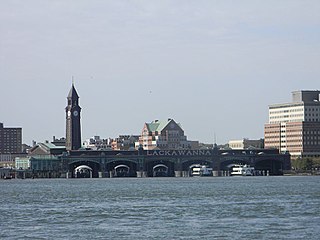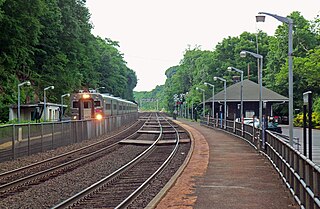
The Main Line is a commuter rail line owned and operated by New Jersey Transit running from Suffern, New York to Hoboken, New Jersey, in the United States. It runs daily commuter service and was once the north–south main line of the Erie Railroad. It is colored yellow on NJ Transit system maps, and its symbol is a water wheel.

Hoboken Terminal is a commuter-oriented intermodal passenger station in Hoboken, Hudson County, New Jersey. One of the New York metropolitan area's major transportation hubs, it is served by eight NJ Transit (NJT) commuter rail lines, an NJ Transit event shuttle to Meadowlands Sports Complex, one Metro-North Railroad line, various NJT buses and private bus lines, the Hudson–Bergen Light Rail, the Port Authority Trans-Hudson (PATH) rapid transit system, and NY Waterway-operated ferries.

The Bergen County Line is a commuter rail line and service owned and operated by New Jersey Transit in the U.S. state of New Jersey. The line loops off the Main Line between the Meadowlands and Glen Rock, with trains continuing in either direction along the Main Line. It is colored on NJT system maps in grey, and its symbol is a cattail, which are commonly found in the Meadowlands where the line runs.

For the purposes of this article, the Jersey City area extends North to Edgewater, South to Bayonne and includes Kearny Junction and Harrison but not Newark. Many routes east of Newark are listed here.

The Northern Branch is a railroad line that runs from Jersey City to Northvale in northeastern New Jersey, and formerly extended further into New York State. The line was constructed in 1859 by the Northern Railroad of New Jersey to connect the New York and Erie Railroad's Piermont Branch terminus in Piermont, New York, directly to Erie's primary terminal in Jersey City, initially Exchange Place, later Pavonia Terminal. In 1870 the line was extended to Nyack, New York, and continued to provide passenger service until 1966. After the Erie's unsuccessful merger with the Lackawanna Railroad to form the Erie-Lackawanna, ownership of the line passed into the hands of Conrail upon its formation in 1976 from a number of bankrupt railroads.

The Central Railroad of New Jersey Terminal, also known as Communipaw Terminal and Jersey City Terminal, was the Central Railroad of New Jersey's waterfront passenger terminal in Jersey City, New Jersey. The terminal was built in 1889, replacing an earlier one that had been in use since 1864. It operated until April 30, 1967.

Pavonia Terminal was the Erie Railroad terminal on the Hudson River located in the Harsimus section of Jersey City, New Jersey. The station opened in 1861 and closed in 1958 when the Erie Railroad moved its passenger services to nearby Hoboken Terminal. The New York, Susquehanna and Western Railway also ran commuter trains from the terminal and various street cars, ferries and the underground Hudson and Manhattan Railroad serviced the station. The station was abandoned in 1958 and demolished in 1961. The site was eventually redeveloped into the Newport district in the late 20th century.

Suffern station is a railroad station in the village of Suffern. The station, located on Ramapo Avenue in Suffern, services trains of New Jersey Transit's Main Line and Metro-North Railroad's Port Jervis Line. Suffern station serves as the terminal for Main Line trains, as trains continue north into Hillburn Yard. The next Main Line station, located in New Jersey, is Mahwah. The next Port Jervis Line station to the north is Sloatsburg. The station consists of two low-level side platforms for trains in both directions, neither of which are handicap accessible for the Americans with Disabilities Act of 1990.

Hawthorne is an active commuter railroad station operated by New Jersey Transit in the borough of Hawthorne, Passaic County, New Jersey, United States. It is the northernmost station in Passaic County along New Jersey Transit's Main Line. Trains coming through Hawthorne service Waldwick, Suffern and Port Jervis to the north and Hoboken Terminal to the south, where connections are available to New York City via Port Authority Trans-Hudson and ferries. The station, accessible only by Washington Place in Hawthorne, contains only two low-level platforms connected by a grade crossing. As a result, the station is not compliant with the Americans with Disabilities Act of 1990.

Glen Rock–Main Line is one of two railroad stations operated by New Jersey Transit in the borough of Glen Rock, Bergen County, New Jersey, United States on the Main Line. The station is named Glen Rock–Main Line to differentiate it from the Glen Rock–Boro Hall station, which lies two blocks east on Rock Road.

Ridgewood is a railroad station operated by New Jersey Transit in the village of Ridgewood, Bergen County, New Jersey, United States. A major transfer station, Ridgewood has two high-level platforms for the Main Line and Bergen County Line.

Ho-Ho-Kus is a NJ Transit station served by the Bergen County Line and Main Line. The station is located in Ho-Ho-Kus, New Jersey, at Brookside Avenue and 1st Street, across the bridge on Warren Avenue from Franklin Turnpike.

Waldwick is a commuter rail station operated by New Jersey Transit in the borough of Waldwick, Bergen County, New Jersey, United States located at the intersection of West Prospect Street and Hewson Avenue. It is served by the Main Line and the Bergen County Line; some trains of both originate and terminate at the station. The station has three tracks, the outer two of which are served by low-level side platforms, which are connect by a pedestrian bridge at their southern ends. As a result, the station is inaccessible for handicapped people as part of the Americans with Disabilities Act of 1990. The multiple-track yard Waldwick Yard is located at the north end of the station. The historic Erie Railroad Signal Tower is between them.

Allendale is a NJ Transit rail station served by its Main and Bergen County lines as well as Port Jervis Line trains. The station is located at the railroad next to Allendale, Park and Myrtle avenues in Downtown Allendale. The station consists of two low-level platforms serving trains heading between Hoboken Terminal and Suffern. Some westbound trains headed for Port Jervis also stop at Allendale. The station has two ticket vending machines along the inbound platform with three parking lots for commuters. The railroad depot, constructed in 1870, is a combined passenger and freight depot, with a waiting area for passengers at the south end of the building while the northern end is unused.

Ramsey is one of two railroad stations operated by New Jersey Transit in the borough of Ramsey, Bergen County, New Jersey, United States. Located on the Main Line and Bergen County Line, Ramsey station is also unofficially known as Ramsey – Main Street due to the opening of Ramsey Route 17 station to the north in 2004.

Ramsey Route 17 station is one of two railroad stations operated by New Jersey Transit in the borough of Ramsey, Bergen County, New Jersey, United States. Named after nearby Route 17, trains at the station are serviced by NJ Transit's Main Line and Bergen County Line, alongside Metro-North Railroad's Port Jervis Line.

Mahwah station is a NJ Transit train station located in Mahwah, New Jersey served by the Main Line, Bergen County Line and a limited service served by Metro-North Railroad's Port Jervis Line.

Rutherford is a New Jersey Transit railroad station served by the Bergen County Line located in Rutherford, New Jersey, United States. The station is located near a traffic circle at the junction of Park Avenue, Union Avenue, Erie Avenue and Orient Way known as Station Square, with a grade crossing on Park Avenue.
The Paterson and Hudson River Railroad was a railroad that operated in New Jersey and connected the cities of Jersey City and southeast Paterson. The railroad was started in 1833.
The Newark Branch was a branch of the Erie Railroad in New Jersey, United States, running between Jersey City and Paterson and passing through the Broadway Section in North Newark, the origin of its name. Inaugurated in the 1870s, the line was last used for passenger service on September 30, 1966, but continues to be used for freight service on a portion of its length.





















